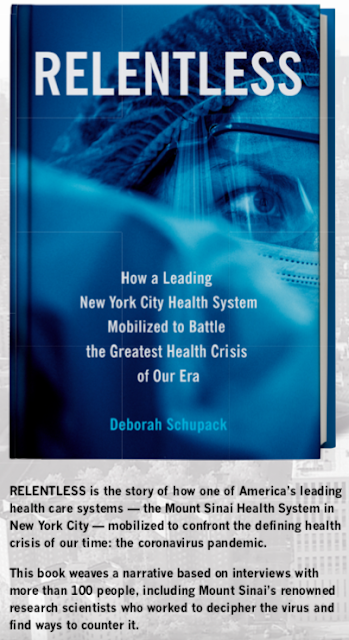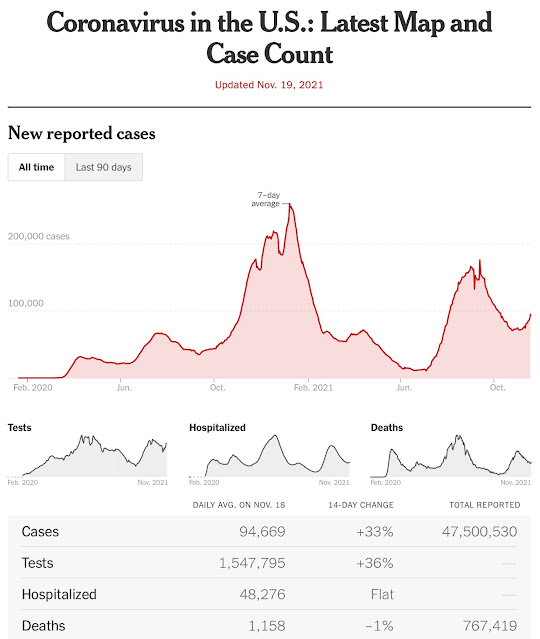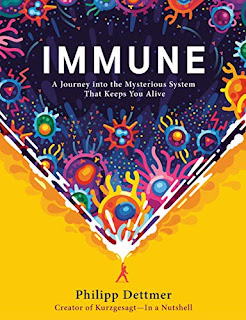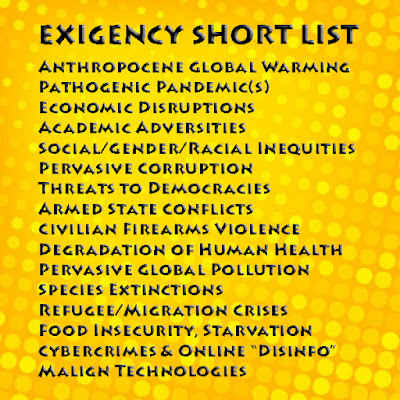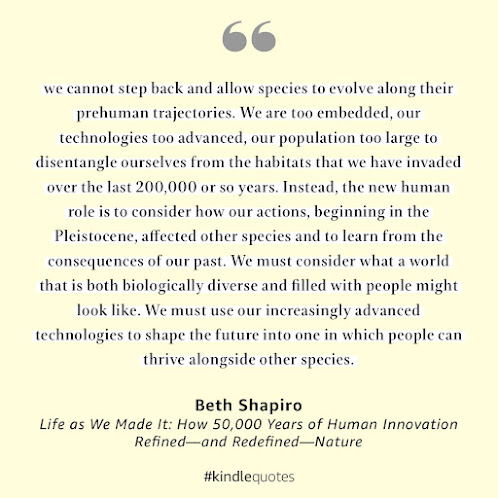Omicron (B.1.1.529): SARS-CoV-2 Variant of Concern
This one arrived packaged in a loose clear plastic outer container, within which was a companion volume.
“Medical research is advancing at breakneck speed. From the creation of infrastructure and tools that can generate and capitalize on enormous datasets, to the ability to edit genetic material, to a more granular and nuanced understanding of the immune system, we now find in the lab and the clinic what was not that long ago found only in science fiction. But what will the future of medicine look like? The articles in this supplement provide a glimpse. Clinicians and researchers at the prestigious Icahn School of Medicine at Mount Sinai offer their insights on the increasing use of artificial intelligence, on pandemic responsiveness, and on drug discovery and development, and highlight systemic changes needed to improve medical education and address health inequity. They are working collaboratively to break down silos, integrate emerging technologies, and advance personalized treatments to ensure that the needs of today’s and tomorrow’s patients will be served.”
 |
| [This collection is brought to you by the Science/AAAS Custom Publishing Office.] |
"The excitement and optimism around the remarkable progress in medical research and treatment is what inspired the creation of this supplement. The Icahn School of Medicine at Mount Sinai, in partnership with Science/AAAS, is spotlighting just some of the extraordinary work being done by researchers and clinicians at the frontiers of medical research. Their hard work and innovative spirit will continue to drive advancements in patient-centered health care, now and into the future."Notwithstanding my reflexive dubiety toward "sponsored content" (marketing stuff posing as neutral, objective content) this material, given the AAAS credibility rep, was not to be dismissed out of hand, in particular given that this blog commenced with a focus on medical/healthcare infotech. Much of the content set forth above remains of abiding interest to me.
Sean Sanders, Ph.D.
Custom Publishing Office
Science/AAAS
Become a Partner
To publish as a Science Partner Journals (SPJ) member, an organization must apply and undergo an evaluation process, regardless of whether that organization seeks to create a new journal or bring to the program an existing title with a prestigious background.
Partner proposals are evaluated based on research quality, scope, and organizational fit with the American Association for the Advancement of Science (AAAS). The program welcomes all scientific disciplines but places an emphasis on new and important scientific research in growing or emerging fields.
Once AAAS and a potential partner organization both decide that a title belongs in the SPJ program, AAAS will act as contractual publisher and service provider for that partner organization. This includes providing editorial training, platform access, and marketing services.
Partners participating in the program will be editorially independent and responsible for the content published in each journal. However, AAAS is highly selective about partnerships and strongly recommends that each partner adopt the Committee on Publication Ethics and the Council of Science Editors or equivalent guidelines to establish a baseline set of practices and standards to which a partner is expected to adhere.
The entire scientific enterprise might be viewed as an attempt to systematically weed out bias from our view of reality. At least, this is a critical component of the scientific method. But bias can be subtle, and can creep in at many stages from conception to citation of published research. The subjects of research may have bias, research methods can be biased in terms of how measurements are made or reported, which comparisons are looked at, the statistical methods used, and how data is [sic] collected. The publication process also may introduce bias, as can the way in which researchers access, evaluate, and cite published studies.
All of these sources of bias can distort the scientific literature and therefore the academic process and the conclusions that scientists and practitioners come to, with downstream effects in many aspects of how we run our society. But the key strength of science is that it can be (when done properly) self-reflective and self-corrective. This self-corrective process should apply not only to the findings of science, but to the process and institutions of science as well. This is one of the main missions of SBM, to examine and reflect upon the relationship among how science is practiced, the findings of science, and the practice and regulation of medicine…
Now we can add one more phenomenon to the list of possible journal biases – nepotistic journals.
In a massive review of publications in 5,468 biomedical journals indexed in the National Library of Medicine between 2015 and 2019, Scanff et al. examined the distribution of authors in each journal. They used two measures to quantify this: the Percentage of Papers by the Most Prolific author (PPMP), and the Gini index (level of inequality in the distribution of authorship among authors).
The authors found that the median PPMP for the journals examined was 2.9%, meaning that a typical journal may have around 3% of the papers they publish have the same author. They also used the two standard deviation model, determining the 95% cut-off for PPMP. They found that 95% of journals had a PPMP less than 10.6%, or that 5% had a PPMP of 10.6% or more. A high PPMP also correlated with a high Gini index, which indicates a highly unfair or biased distribution of authors. Further, and perhaps very significantly, they also found a correlation between the specific most prolific authors and a reduced time to publication, such as the percentage of papers that are published within three weeks of submission. This might indicate an expedited or even inadequate review process.
But the most significant correlation they found was that among that 5% of journals with the highest PPMP, in 60% of the cases the most prolific author was a member of the editorial board. This pattern held true when only research papers were considered (therefore not counting letters or editorials that might be disproportionately written by the editors). These were the journals considered “nepotistic”…
…there seems to be a subset of nepotistic journals that cater to one or more members of their editorial staff, allowing them to publish a large number of papers with little editorial barrier. This can be a method of gaming the system, affecting academic promotion and the awarding of grants. These editorial authors can also use these same papers to deliberately reference other papers in the same (or a sister) journal, therefore gaming the impact factor measure also.
One other concern that this paper could not examine is the scientific quality of nepotistic papers. Given the favorable bias and reduced editorial review, there is concern that low quality science is finding its way into the literature via this method….
The simplest partial fix to this problem (like many things in science) is transparency. Journals might be required to publish alongside their impact factor (a measure of how often they are cited) their PPMP and Gini index. Because prolific journals may mask their nepotistic practices by their high number of publications, publishing the raw number of publications by their most prolific author also helps. Further, the number and/or percentage of papers published in the journal by an author on the editorial staff is critical. At least with this transparency fellow researchers and academics on promotion committees can easily detect blatant nepotistic practices, reducing the benefit of this practice.
"Cronyism is the practice of partiality in awarding jobs and other advantages to friends or trusted colleagues, especially in politics and between politicians and supportive organizations. ... Whereas cronyism refers to partiality to a partner or friend, nepotism is the granting of favour to relatives." —Wiki
EXPOSOMICS
Integrating exposomics into precision medicine and public health
Robert O. Wright*, Kecia N. Carroll, Rosalind J. Wright
Precision medicine, which now primarily utilizes genomic and electronic health record data, holds the potential to transform medical practice. Recent calls to expand the field’s purview to encompass all factors that predict health (1–3) underscore the need to include environment (4, 5), as human health and disease are shaped by a range of lifelong exposures and their resultant biological responses. The emerging exposome concept addresses this complexity by studying the effects of all health-relevant environmental factors over the life course (6–8). The 20th-century concept of “nature versus nurture” needs to be tossed aside, as genetics and environment do not compete—they work hand in hand through interactions in which our environment (i.e., where people are born, live, develop, learn, work, play, and age) triggers biological responses that are determined in part by our genetics in a lifelong, iterative process. However, there is not yet a systematic plan to integrate exposomics into precision medicine. Advances in computational science, medical informatics, remote sensing, geographical information systems, and analytical chemistry now provide powerful research tools to facilitate the incorporation of exposomics into precision medicine and public health (9–11).
Understanding our environment is critical to advancing human health and eliminating health inequities. The broad-ranging effects of climate change consequent to rising global average temperatures, increasing atmospheric carbon dioxide (CO2), associated extreme weather events (i.e., heat waves, droughts, floods, and hurricanes), and altered ecosystem functioning and biodiversity, have alarming potential to magnify toxic environmental exposures and amplify consequent health disparities (Figure 1) (12). Climate affects the exposome both directly and indirectly to influence the spatial and temporal distribution of infections, asthma, allergies, mental health, and dozens of other chronic diseases. Also, rates of cancer, diabetes, heart disease, and neurodegenerative diseases, among other complex diseases, continue to rise with minority groups such as Blacks, Latinx, Native Americans, and Asian Americans experiencing increased disease morbidity and/or severity. Structural racism, including redlining, has segregated minoritized groups to live in low-income communities where increased exposure to psychosocial stressors, air pollution, physical environmental toxicants, and reduced access to healthy food and green spaces are concentrated. The systematic segregation of persons of color through redlining policies has significant public health implications (13). These environmental disparities go beyond pollution, particularly for indigenous populations, as cultural practices commonly involve local food and water, further exacerbating social inequities. Health inequities arise from variable—and too often predictable—imposed environments that link to social determinants of health. The geospatial diversity of the exposome underlies its key role in explaining health inequities. Broad categories of the human exposome include nutrition, infections, chemicals, physical environment, and sociocultural conditions that act as psychosocial stressors. Because exposomics encompasses the interconnections among our social, nutritional, and chemical environments, it holds great promise for elucidating root causes of recalcitrant health disparities…
_____________________________________
Department of Environmental Medicine and Public Health and the Department of Pediatrics, Icahn School of Medicine at Mount Sinai, New York, NY
*Corresponding author: robert.wright@mssm.edu
 |
| Click to enlarge. |
Heavily mutated Omicron variant puts scientists on alert
Researchers are racing to determine whether a fast-spreading coronavirus variant poses a threat to COVID vaccines’ effectiveness.Researchers in South Africa are racing to track the concerning rise of a new variant of the SARS-CoV-2 coronavirus that causes COVID-19. The variant harbours a large number of the mutations found in other variants, including Delta, and it seems to be spreading quickly across South Africa.
A top priority is to follow the variant more closely as it spreads: it was first identified in Botswana earlier this month and has since turned up in a traveller arriving in Hong Kong from South Africa. Scientists are also trying to understand the variant’s properties, such as whether it can evade immune responses triggered by vaccines and whether it causes more or less severe disease than other variants do…



